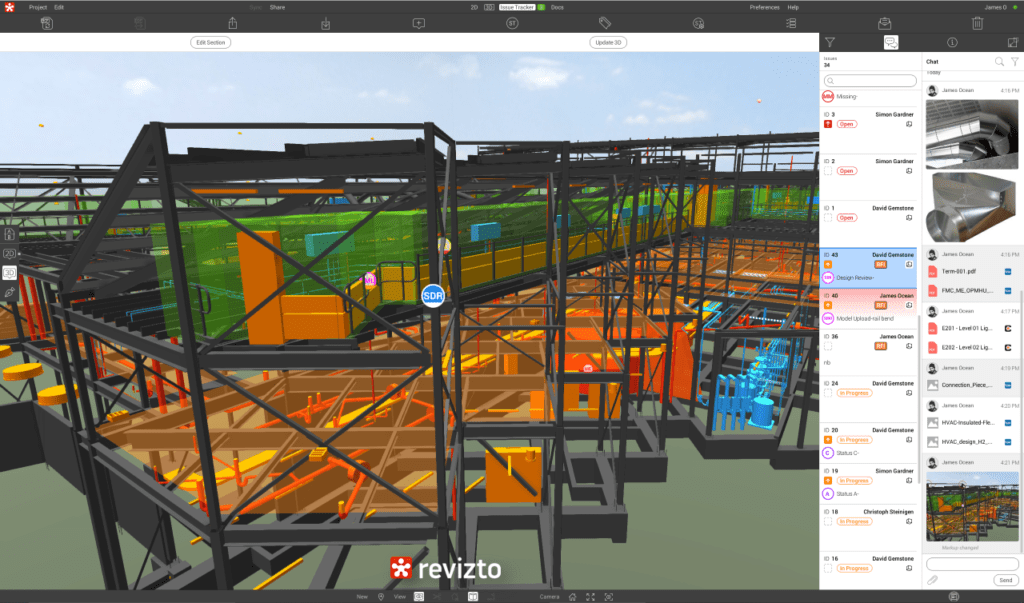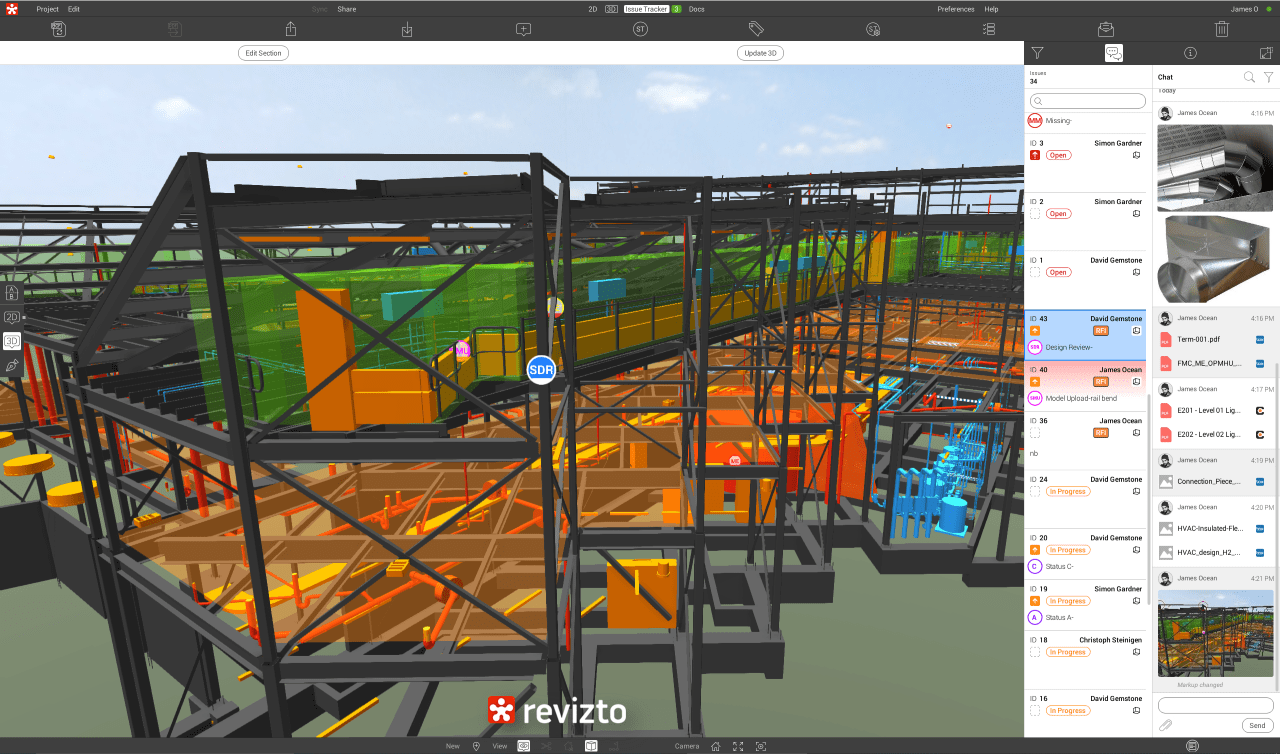The Importance of BIM Data Management in Construction. Why BIM Database is Important?
- Introduction
- Understanding BIM data types
- Foundation of BIM data
- Benefits of BIM database management
- BIM Data Use Cases in Design
- BIM data workflows
- Two questions to think about before starting interaction with BIM
- Best practices for BIM data management
- Future developments of BIM data and what to expect next
- Conclusion

Introduction
Building information modeling (BIM), in its current iteration, is the proverbial backbone of modern construction projects, offering a centralized solution for many of the challenges existing in the construction environment. While it was originally developed for the representation of future structures, not unlike CAD models, the evolution of the concept of BIM has introduced a lot of capabilities to the methodology which can now help manage the entire lifecycle of a building from start to finish.
The biggest appeal of BIM as a whole is the ability to make the construction processes faster, cheaper, and easier to deal with. All of that is possible because of the large amounts of data that each of the BIM project parts possesses. BIM itself is not just 3D modeling, it’s much more complicated than that.
Since one of the main purposes of Building Information Modeling is basically data transfer between different parties within the project, it’s no surprise that BIM data in general plays a big role in the overall process. BIM data is what makes BIM projects so information-rich, and this data is also used to determine potential clashes and problems, among other benefits.
Core concepts of BIM data management
Data management capabilities are at the forefront of BIM’s feature set, offering a better understanding of projects and more informed decision-making due to the ability to create relationships between information segments within the same BIM model. An interconnected approach like this makes it possible to retroactively update every single element by modifying only one segment of the structure, providing incredible levels of data consistency.
BIM data management provides a single source of truth for all project stakeholders, with real-time updates that eliminate information mismatches. Extensive version control assists with accountability and issue resolution, while extensive accessibility makes it possible to restrict access to information based on specific user roles for better security.
Understanding BIM data types
BIM data is an overarching term, and it can take many forms. All BIM data can be separated into three noteworthy categories for the sake of convenience:
- Geometric data. This includes physical dimensions, spatial relationships, and visual representations of building elements. It also includes information about the location and orientation of specific objects.
- Documentation data. This covers project requirements and potential constraints, as well as construction methodologies and design intent documentation. All information regarding regulatory compliance also falls into this category.
- Non-geometric data. This can be separated into cost information, installation instructions, maintenance schedules, and performance requirements. All properties and specifications of building objects are also included in this category.
Data classification
Of course, the classification method above is not the only option. For example, BIM information can also be classified according to its structure or use:
- By Structure:
- Structured information: everything that is organized in predefined formats, such as databases, parameters, etc.
- Unstructured information: the rest of the data, which is not organized as strictly, such as notes, documentation, and so on.
- By Use:
- Operations data: information that supports facility management tasks.
- Construction data: information that guides the building process.
- Design data: information that shapes design decisions.
Role of BIM data
BIM data has several important functions at different project phases, including:
- Project planning includes examples such as site analysis, initial cost estimation, and feasibility studies, among others.
- Design development has a large selection of use cases for data, including clash detection, performance analysis, and many other forms of design optimization.
- Project execution covers everything BIM data can assist with in the on-site construction phase, such as quality control, resource management, construction sequencing, etc.
- Long-term management begins right after construction is complete, with BIM data assisting with asset tracking, space management, and facility maintenance tasks.
The foundation of interconnected information makes it possible for project teams to deliver projects with higher efficiency by reducing the number of errors and making more informed decisions.
Foundation of BIM data
The foundation of effective BIM processes is in the structure and maintenance of construction information. A competent foundation makes it possible for information to flow seamlessly within the project, offering the most up-to-date data to any stakeholder at any point in time.
Structure of data
The sheer complexity of the average construction project requires a systematic approach to the organization of data. A clear understanding of proper data structures is a necessity when it comes to managing the large masses of data generated at different stages of a project’s life cycle.
Standardized formats are at the heart of the structure of BIM data, greatly improving the efficiency of information exchange. The formats themselves serve many purposes and are often used in combination as a comprehensive data ecosystem:
- IFC, or Industry Foundation Classes, is the primary open-source format for BIM data exchange. It enables communication between a multitude of software platforms and can store both geometric and non-geometric information. Additionally, it can work with attribute data and even transfer relationships between building elements.
- COBie, or Construction Operations Building Information Exchange, is another standardized data format that focuses more on non-geometric data for facility management purposes. It captures equipment specifications, maintenance requirements, and warranties and is typically delivered in the form of structured spreadsheets.
- XML-based schemes are a somewhat uncommon format for data exchange that support custom data structures for highly specialized applications. They are common in building systems that rely on sensor data and can be used to facilitate automation and integration with other environments.
Another important element of effective BIM implementation in addition to standard file formats is a robust data organization system that simplifies the approach to BIM data management. Uniclass, Omniclass, or Uniformat classification are the three primary options. Metadata management is just as important, and it is an essential part of maintaining order in complex BIM environments.
Data quality
Quality assurance in the context of BIM is not just basic error-checking. It is also a comprehensive approach to the reliability and usability of data from the start to the end of the project’s life cycle. Quality standards in BIM can be represented by a selection of frameworks and regulations, with the two most notable examples being ISO 19650 and LOD protocols.
ISO 19650 is an international standard for BIM data management that defines how most information management processes should be conducted. It sets requirements for data quality and data exchange while establishing roles and responsibilities in this workflow.
The Level of Development protocol is a set of standardized specifications for the quality of BIM models. It defines the level of detail required for each project phase while establishing modeling accuracy requirements. It is also responsible for guiding progressive model development and can even be used to define the reliability of specific objects in a project.
Data verification methods
Data quality in itself is a rather challenging topic, considering how much effort it takes in the context of complex BIM environments. In that sense, the introduction of automatic and manual verification processes is practically mandatory to ensure comprehensive quality control over every single piece of data in a BIM model.
Both automated and manual review processes are used in a complementary manner and are not positioned as alternatives to one another. The former can verify the consistency of classification, spatial coordination, the validation of geometry, and the integrity of relationships with little to no human involvement. The latter is mostly used to verify compliance with specifications, cross-reference documents, conduct quality assurance reviews, and check coordination between departments.
Data maintenance
Data integrity maintenance in the long term also necessitates a somewhat standardized approach to data management and version control. Making sure that information is reliable and accessible throughout the entire project, from start to finish, is the primary purpose of these processes.
Version control is an essential part of change tracking and data consistency monitoring via collaborative workflow support, model state preservation, revision history maintenance, and so on.
Data integrity assists with protecting information from corruption or erasure with robust maintenance procedures, including archive management, error detection, corruption prevention, and a variety of backup and recovery procedures.
The issues of data validation and data maintenance are combined into a single framework under the name of quality assurance. A more systematic approach can assist with the consistency of data quality levels throughout the entire project realization process. Aside from these elements, QA also includes regular audits and updates, continuous monitoring during use, and a selection of security measures, including encryption, activity logging, RBAC, user authentication, and many other alternatives.
Benefits of BIM database management
As with BIM itself, you’ll need to actually start using BIM data models to their fullest to reap all of the benefits on all of the phases of your projects. Below we’ll list a few reasons why BIM data management should be used in the first place:
- Improvements in the project control department through improved quality and cost avoidance: It’s not uncommon for the complexity of the project to increase in accordance with its size. This often brings additional problems, such as incorrect building material orders, or even order duplication. As such, this can be solved with the effective supply management that BIM data management can help with – by monitoring quantities of building materials, streamlining both the procurement and the delivery schedules.
- Easier communication and collaboration with automated dashboards: Stakeholder meetings are an important part of any project, there’s no doubt about that. The major part of communication and collaboration is often done through those. As such, it’s also necessary for stakeholders to have supporting material in the process, to make it easier to understand more complicated matters. Right now, the distribution of said materials can be done much easier in the digital format thanks to the projects that are rich with BIM data, making it easier to collaborate with different stakeholders.
- The usability of data insights that help with saving both time and money: Unfortunately, the building sector has had problems with both productivity and efficiency for a while now. This is why the contractors are always looking for a way to increase these parameters without sacrificing the overall project quality. Lucky enough, the addition of BIM to the project allows constructors to lessen significantly or completely eliminate the time that was previously spent analyzing the BIM data acquired from various designers in various different formats. BIM always strives to work within either one single format or a format that’s supported by all of the software appliances involved.
- Easier to deal with geometric clashes: Speaking of different formats, the addition of BIM as a whole and more or less unified BIM data model formats allows for designers to find out about and resolve basically all of the geometrical clashes as early as the design stage. It’s possible to benefit from integrating a BIM model with almost any data or model type, including piping, electrical systems, ventilation ducts, and so on.
- Audits and compliance: Another field that the introduction of BIM data heavily benefits from is auditing and compliance with various standards. For example, digital project models are supposed to adhere to either company’s own data standards or one of the globally accepted ones (COBie, Uniclass, etc.). To meet the compliance requirements, it’s not uncommon for BIM consultants to perform audits of the model for that exact reason. Luckily enough, the existence of BIM as a system leads to a significantly easier audit process in general thanks to the data unification, among other benefits.
- Handover improvements: The existence of an accurate project model earlier in the design stage makes it far easier to complete the entire project with little to no clashes, errors, or time delays. Full data compliance and reduced costs are also included in the package so that both sides can benefit from the addition of BIM in the first place.
BIM Data Use Cases in Design
Another way of seeing the extent of benefits that the addition of BIM data models provides is by listing a few more specific BIM data use cases in the design stage:
- Accurate drawings and documentation: The addition of BIM as an entire system allows the companies to generate much more accurate and consistent drawings and documentation, including, for example, floor plans and schedules – even if the floor plans were revised a few times before, the connections between different systems has led to the schedule being automatically calculated and changed every time in accordance to the changes in the floor plans.
- Complex calculations: Speaking of calculations, BIM is also incredibly useful in that department, automating some of the hardest calculations and lessening the possibility of a human error mid calculation to as close to zero as possible. For example, it’s possible for a virtual representation of fire alarm design to automatically calculate the electrical loads for each of the circuits so that there’s no overload on the electrical system overall in the finished form of a building.
- Easier to present the information to people less connected with the design job itself: The rapid pace of the overall technological improvement has led to the essential team members becoming more and more distant with the recent information, about some design stage issues, or something more technical. The addition of BIM allows these people to have a much easier time interacting with the system as a whole, and even draw their own benefit from the introduction of BIM data, making it possible to, say, monitor the changes in the model data to be on the lookout for the potential clashes and other information-related problems.
While the abundance of use cases does demonstrate the immediate benefits of BIM in different project realization phases, we also need a clear understanding of the entire workflow throughout the project’s life cycle to be able to implement a BIM methodology successfully. In the next section, we examine how BIM data workflows can be integrated into different project phases.
BIM data workflows
The implementation of BIM data workflows is a fundamental shift from traditional project management approaches. BIM-assisted workflows can be integrated with every single stage of project realization, from early design to post-construction maintenance. In a perfect implementation, a BIM data workflow provides a seamless flow of information between all stakeholders at every point in the project realization process.
Project lifecycle integration
Project lifecycle integration is the backbone of any successful BIM implementation. Businesses can dramatically reduce the number of errors and improve process efficiency by maintaining data continuity at different phases of construction projects. We cover three primary project realization phases here:
- Design phase.
- Construction phase.
- Maintenance phase.
The design phase is the foundation for every other change to the project, which is why it needs an effective data management environment the most. Modern BIM workflows have the ability to establish dynamic, collaborative efforts with real-time data sharing that replaces the traditional design workflow with ease.
The design phase is where most teams focus on creating the original BIM model, with all the relationships and parametric objects included. In the future, the models created (and subsequently merged) will be treated as a single source of truth for all stakeholders, which makes it incredibly important to make the models themselves as accurate and true-to-life as possible.
The most important elements of the design phase when it comes to data management are:
- Performance analysis
- Documentation generation
- Design validation;
- Simulation data integration
- Clash detection processes
- Versioning, etc.
The construction phase is where digital models are transformed into physical objects, necessitating precise coordination between many stakeholders and activities. The translation of design data into actionable construction information is the primary goal of BIM workflows at this stage, ensuring complete accuracy and maximum efficiency.
Construction teams rely on BIM data to coordinate on-site activities and to track real-time progress. The introduction of 4D BIM also allows for precise planning and sequencing processes to be conducted using the BIM model as the baseline, and the existence of material quantity takeoffs ensures accurate resource allocation while reducing waste.
The most noteworthy elements of the construction phase are:
- As-built documentation
- Quality control
- Site coordination
- Progress tracking
- Deviation tracking
- Inspection data integration, and so on
The maintenance phase covers the rest of the project’s life cycle after the construction process is complete. This is where the comprehensive asset information in a BIM model becomes invaluable for long-term facility management tasks. At this stage, BIM workflows are responsible for relevant building information by capturing and structuring it properly before providing it to building operators or facility managers.
Operational and maintenance workflows use BIM data to create and manage comprehensive repositories of digital assets that can assist ongoing building management efforts with maintenance schedules, warranty information, detailed equipment specifications, performance monitoring data, etc. Both proactive maintenance strategies and efficient building operations can be performed far better with access to this data.
Data exchange and collaboration in BIM
Another important element of successful BIM implementation is collaboration and data exchange between stakeholders or project teams. The complexity of construction environments necessitates the use of robust data exchange protocols, making collaborative efforts and frameworks more and more important as time goes on.
Interoperability in BIM workflows goes far beyond file compatibility. It is an entire ecosystem for seamless data exchange between stakeholders, platforms, and solutions. The highly varied nature of the BIM software market does make it somewhat challenging, but the implementation of open standards such as IFC or BCF was intended to resolve precisely these issues. Additionally, adherence to LOD standards and specifications should greatly simplify interdisciplinary communication, ensuring that the entire project model meets all of the detail requirements at all phases of project realization.
Common data environments (CDE) are a different approach to the issue of interoperability in BIM environments. CDEs can serve as digital hubs for all project information, acting as intermediaries of sorts that simplify data sharing and collaboration processes. The capabilities of some more modern CDEs also include version control, real-time collaboration, complex workflow management, and a number of other capabilities outside of the standard file storage feature set.
Two questions to think about before starting interaction with BIM
BIM integration is not an easy feat in the slightest, and it’s expected – with the number of benefits that it can bring. The transition can be seamless if thoroughly thought through before implementation. Two questions are important, especially from the facility management standpoint, but also practical for the BIM data as a whole:
- What would your BIM format be?
Data usage in BIM is done via either one specific software provider that shares their own data formats with the relevant software or via one of the universally accepted file formats from standards like COBie, the one that most of the software providers can work with at least on the read-only basis.
- What information is needed for facility management?
BIM models often contain a plethora of different data about different elements of the project, sometimes down to the screw size. Both the contractor and the owner must understand the importance and the impact of BIM data and why it is needed for facility management. Any existing data about the project might prove useful in unexpected ways that the owner would not think of, so learning about that might be beneficial for the project in general.
Best practices for BIM data management
The establishment of robust data management practices is an easy way to ensure the successful implementation of the BIM methodology. Data integrity, security, and accessibility during the entire project lifecycle are mandatory factors that are difficult to provide for large projects without proper data management practices. Here, we would like to mention three of the most noteworthy best practices for BIM data management:
- Security and access control
The modern digital construction environment requires the maintenance of a high level of data security without restricting appropriate access to information. Role-based access control systems are used as a foundation of this approach, simplifying the process of managing which specific user groups can and cannot access data.
Other important security measures worth mentioning here are widespread data encryption standards, comprehensive incident response plans, and third-party access management, all of which are a necessity in a modern BIM environment.
- Version control
Effective version control simplifies the delivery of the most relevant and accurate information for each stakeholder while also providing a substantial number of other advantages, including the ability for multiple users to work on the same file, comprehensive modification logs for the sake of accountability, and even the ability to track model elements and their relationships within the BIM model when possible.
- Backup and archival processes
Comprehensive backup and archival strategies are a necessity in a modern digital environment, and BIM systems are no exception. Both of these processes have their own use cases, with backup and recovery workflows providing security capabilities, while data archival simplifies the storage of large masses of data and makes it cheaper in most cases in which primary storage is very expensive.
Future developments of BIM data and what to expect next
Despite the fact that BIM technology has been groundbreaking for construction workflows, it also continues to evolve and improve as time goes on. A lot of this change is driven by the most recent developments in computing power, as well as the widespread adoption of technologies such as artificial intelligence and machine learning. A clear understanding of the trends emerging in the BIM industry should provide organizations with a better overview of what to expect from these technologies in the future.
Artificial intelligence and machine learning
Both AI and ML are pushing BIM to evolve even further, providing features such as automated clash detection, design optimization, predictive maintenance, and so on. The purpose of these technologies is to analyze patterns, predict issues, and identify optimal solutions to these issues without negatively affecting total construction costs, energy efficiency, and other building parameters.
Cloud-based BIM solutions
Cloud-based BIM solutions are often seen as the next step in the evolution of BIM, given their unprecedented accessibility and collaboration options. So far, there are two possible options:
- Real-time cloud collaboration platforms make it possible to have truly concurrent workflows with no interruptions.
- Hybrid cloud solutions can combine the security of on-premises environments with the advantages of cloud computing software.
Both of these types of platforms offer unprecedented scalability that will make it much easier to handle more complex BIM projects without creating a massive burden on local IT infrastructures.
Integration with other technologies
Another potential avenue for the development of BIM in the future is successful integration with even more technologies, including some of the latest examples:
- Augmented reality applications
- Digital twins
- IoT sensors
- Smart building systems
- Blockchain technology, etc.
All of these technologies contribute to a more connected and intelligent BIM management process, representing the next step in the evolution of BIM data management, which will also affect construction processes in a major way.
Conclusion
BIM on its own is a big change for the industry, and its recent growth has been exponential. Some people say that we’re already past the stage of questioning if BIM should be used or not, now it’s more about learning how else can everyone benefit from the addition of BIM databases.
All in all, the advantages of BIM data are massive and diverse, and it’s easy to dismiss it entirely. But ignoring this list of potential benefits would probably be an enormous waste of potential for the vast majority of companies who are still not sure if the BIM is worth it after all. And it is worth it, throughout all of the project phases, in multiple ways, the benefits of BIM are numerous, and the potential of BIM data is enormous.




